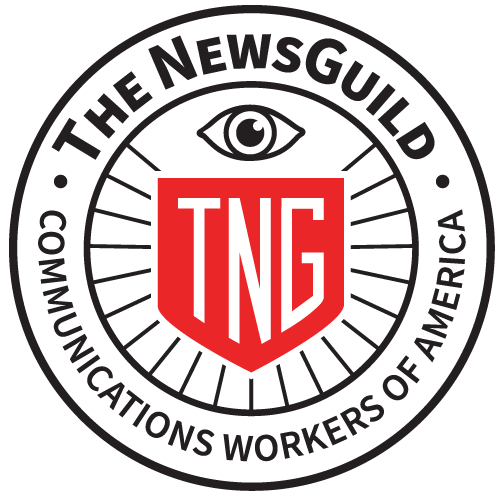The first time union members at the New York Times attended a bargaining session in big numbers, the company freaked, said Davey Alba, a bargaining committee member who is a technology reporter at the Times. “Management refused to speak for 30 minutes and made a big show of being insulted that we brought all these people.”
But that just piqued workers’ interest.
Bargaining Committee members began preparing for a battle, Alba said. They organized around their coworkers’ natural inclination as journalists to want to observe and around the hypocrisy of a news organization, founded on the principle of transparency, trying to hide bargaining from the workers who would live under the terms that were being negotiated.
“Open bargaining helps to build the engagement and participation that is key to winning a strong contract. It’s how members at @latguild won a groundbreaking first contract. This is why management fears it, and why we insist on it,” the NY Times Guild explained.
Management eventually agreed to having as many employee observers as the union’s Bargaining Committee wanted, without much of a battle.
“Having members be there really does improve the contract itself,” Alba said. “When you have someone coming in for the first time and seeing how it can change their work life, it’s galvanizing.”
That’s the big lesson of open bargaining, Alba said, speaking at a NewsGuild webinar in December.
Max Eddy, the unit chair of The NewsGuild’s Ziff Davis unit, said, “Union-busting lawyers are not a particularly likeable bunch. They’re arrogant. They’re pedantic.”
Open bargaining, where union members see them in action, spurs workers’ engagement in a way that hearing about negotiations secondhand never could, he said.
And it makes a difference when workers hear managers – who they often consider friends – say they don’t deserve a raise. It doesn’t break their friendships, Eddy said, “but it makes them mad and makes them want to get more involved.”
During negotiations in 2021, PCMag Bargaining Committee members focused on mobilizing union members to attend the sessions they considered strategic.
At a session on pay, they organized workers to give presentations describing the impact of low wages. Workers testified that they just didn’t have enough money. That they couldn’t afford medication. That they were using office snacks to supplement their meals.
It had a big impact on management and on other union members, Eddy said.
The session empowered union activists to build support for a walkout and strike authorization vote that ultimately led to ratification of their first collective bargaining agreement last June, he said.
Maureen May, president of PASNAP, the Pennsylvania Association of Staff Nurses and Allied Professionals, said that after 21 years, open bargaining is the norm.
In 2010, it prepared PASNAP members for a 28-day strike against Temple University Hospital, she said.
Management proposed adding a non-disparagement clause to the contract and told nurses at the bargaining session, “If you want your constitutional right to speak, go work somewhere else.”
Healthcare workers could never agree to a gag rule, May said. “They want to be able to speak out about conditions at the bedside in order to advocate for the patient.”
Open bargaining presents an opportunity to educate workers about their contract – and their power. “We don’t know any other way but to always threaten to strike,” she added. “That is the peak of your power. The second before you sign that contract.”
The nurses won a strong contract and returned to work together.
So, how exactly does open bargaining work?
The specifics vary. During their first foray into open bargaining at the New York Times workers would just show up, management objected and a lot of time was spent arguing over it, Alba said. Management eventually agreed to allow as many workers to attend as the union Bargaining Committee wanted and the bargaining committee agreed to give management 48 hours’ notice of who would attend. They used a Google form to sign up participants.
The committee at Ziff Davis took a different tack, Eddy said. “We never defined the size of our bargaining committee and we never gave ground that this was a topic for discussion,” he said.
Only designated people are permitted to speak during the bargaining, but observers can participate through union-only chat groups or caucuses during breaks in bargaining. At Ziff Davis, workers called out lies in the chat, giving negotiators the opportunity to debunk management’s talking points in real time, Eddy said. At the Times, the committee launched a bargaining Slack channel where workers often provided anecdotes in support of arguments union negotiators were making.
Union negotiators also put a lot of effort into preparing observers in advance about what to expect and summing up the experience afterward. At the New York Times, the bargaining committee issued shop papers after every negotiation session.
NewsGuild President Jon Schleuss, who moderated the discussion, said open bargaining is one of the union’s key messages. “This is about control and transparency for our membership and ownership of the process by our membership.”
To learn more about open bargaining, see Turning the Tables: Participation and Power in Negotiations by Jane McAlevey and Abby Lawlor, which features case studies, including NewsGuild contract campaigns at the Los Angeles Times and Law350.
Photo at top: The Ziff Davis Creators Guild had great participation at a bargaining session on wages.

